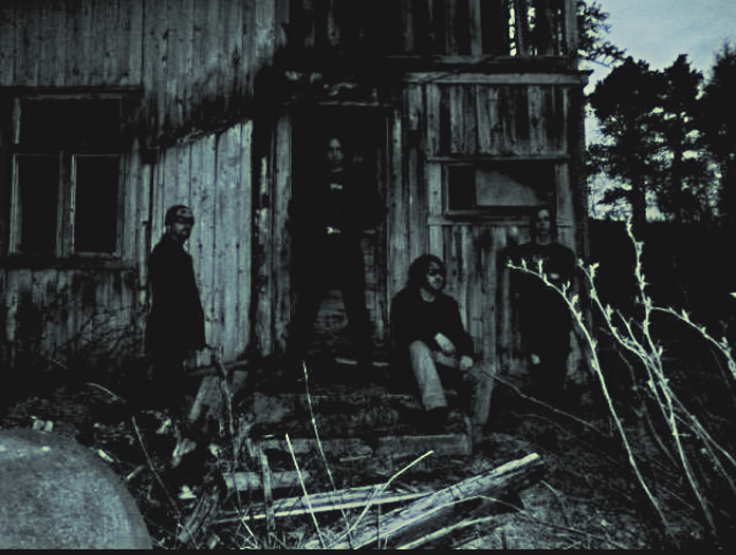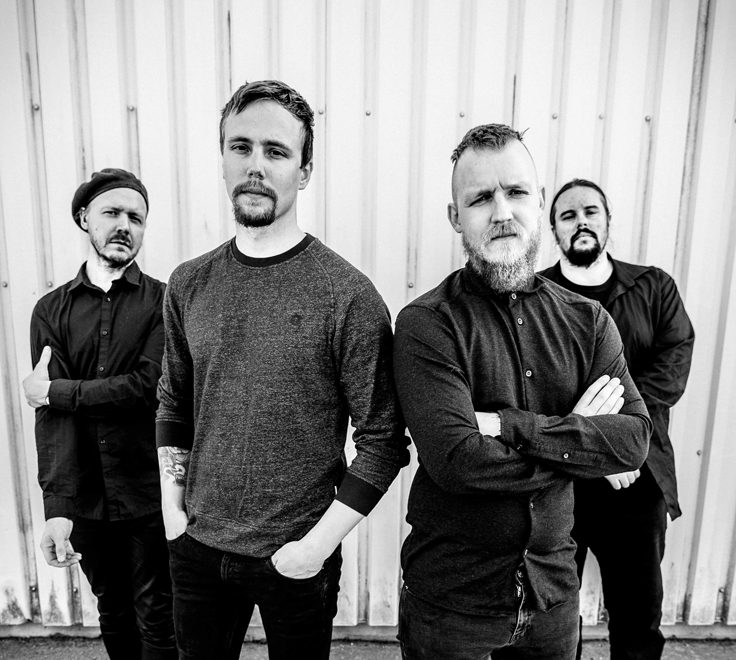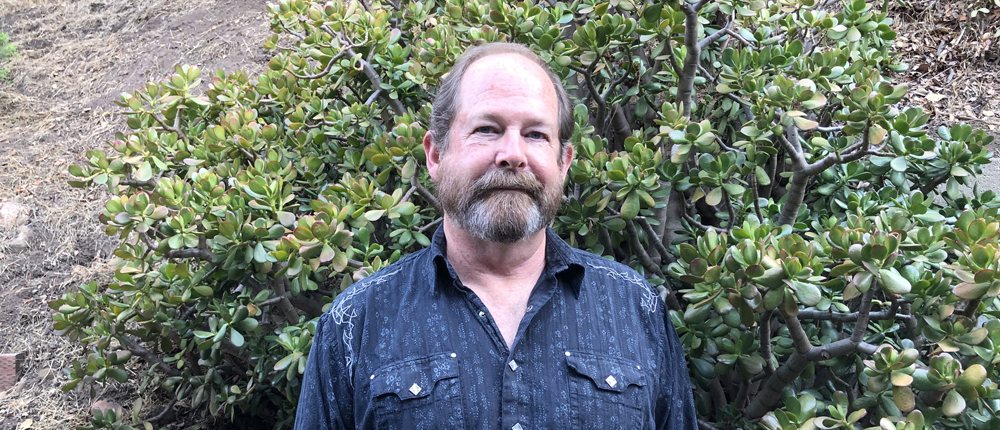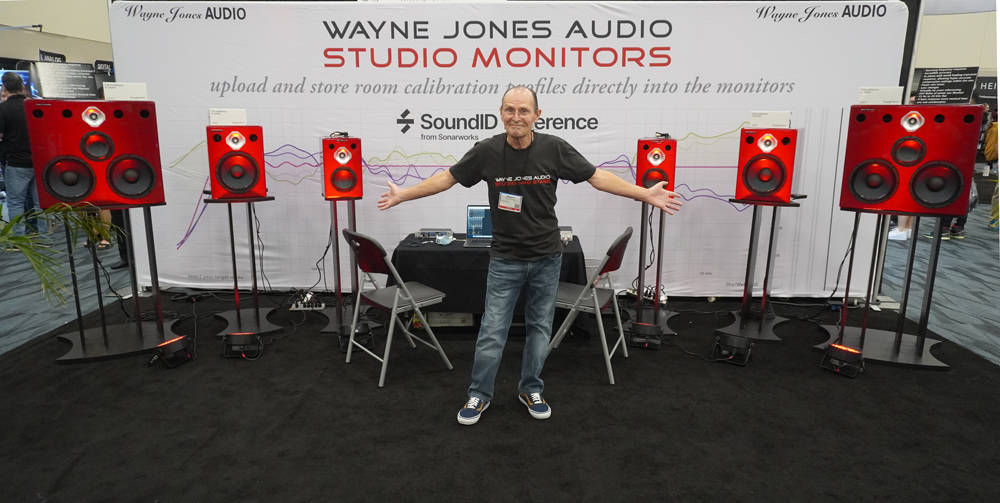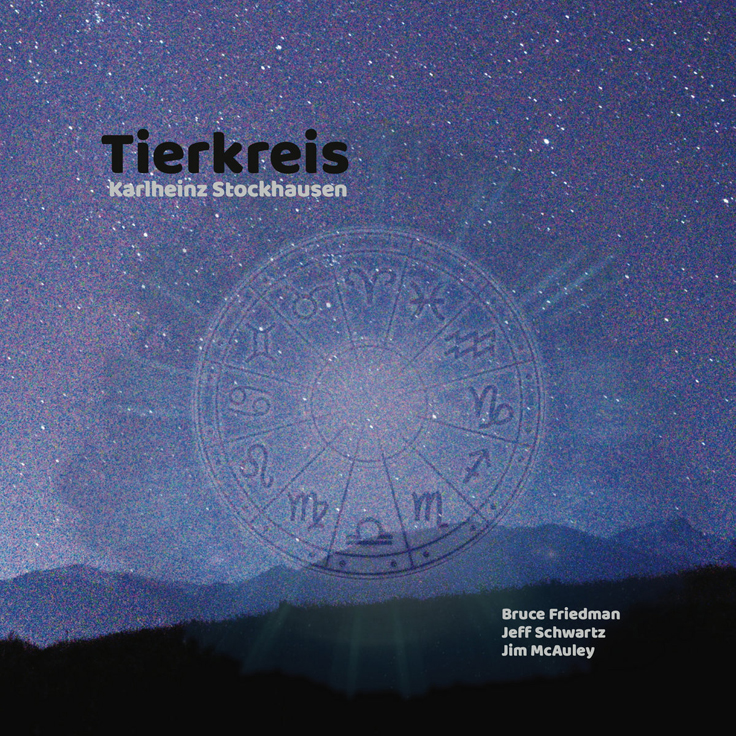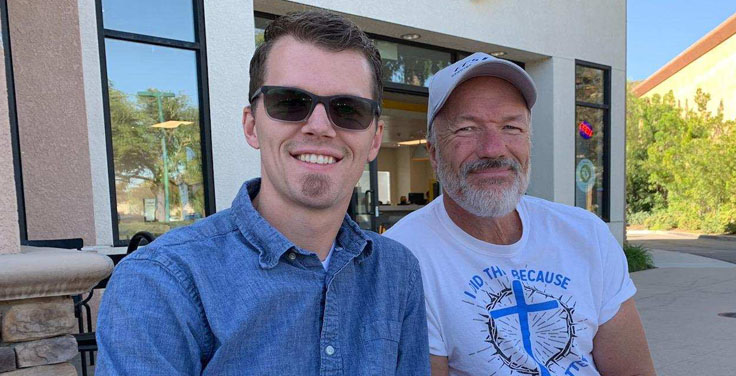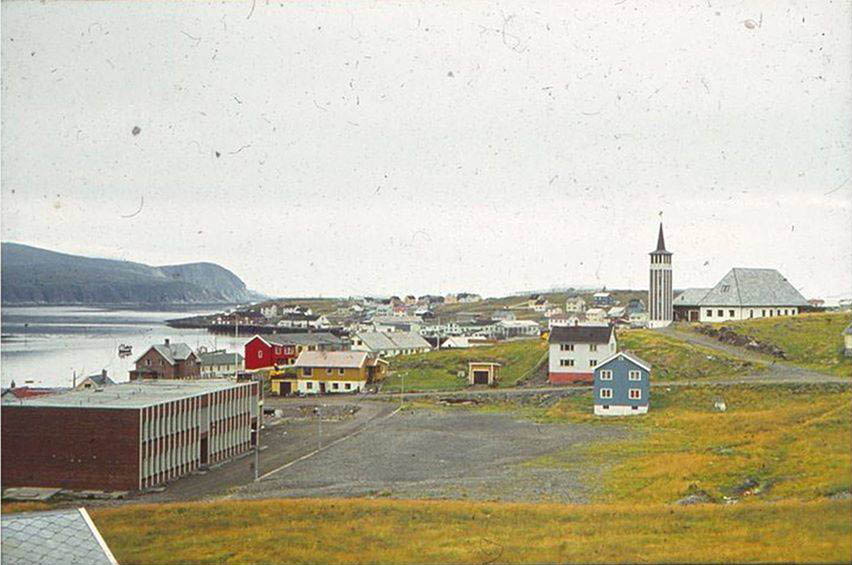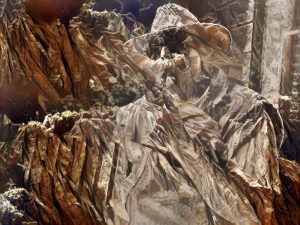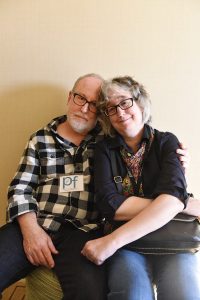Marius Leirånes. Photo by Natalie Jensen, used with permission.
A few miles south of the arctic circle, in the small village of Rognan, Norwegian musician Marius Leirånes has, for decades, been dreaming up dark musical fantasies. Although his influences are diverse, he and his long-time friend and collaborator, Jostein Haugen, have plumbed the depths of black metal, and its variants. In 2017, the two launched Pixie Ninja, an instrumental project of remarkable depth and complexity. The band recently released their 2nd album, Colours Out Of Space, an homage of sorts to the American horror author HP Lovecraft. Leirånes also completed his first solo project, Langtidsperspektiv (long-time perspective), which is due to be released in the spring. All his work is, in some way, connected to the landscape of his home.
My birthplace is located in the northern part of Norway, a place called Mo I Rana. I grew up with my grandparents until I was 6 years of age. After that, my grandparents sent me into foster care across the other side of the mountain, in a small town called Rognan. The very place I live today. I guess they couldn't deal with a 6 year full of energy. So it was the best solution.
What was it like to be disconnected from your family?
I have trouble relating to that, today. I guess it must have been hard, but the family I grew up with here in Rognan were a sweet and loving family. Because of that, I have actually never thought much about it. I have never felt like a outsider, if you know what I mean. They treat me like I am they're own. Still, to this day.
I know that music is important in the Norwegian education system, but was it a part of your family life, too?
My dad fed us plenty with bands like Pink Floyd, Dire Straits, Purple, ELP, and tons of other genres. So music has always been a big deal of my life.
What instrument did you study in school?
I played cornet for a year and so. Nothing else besides that. My interest for playing instruments came much much later. It came gradually when I was in my early twenties. A friend of mine asked if I would like to learn to play guitar. So I bought an electronic guitar and started practicing. A year or so later, I met up with Jostein. After we got well acquainted we decided to start up a Black Metal band.
What was the appeal of that specific genre?
I've been through all the genres actually. In my youth I listened to boy-band music, and a lot of death metal music like Sepultura, Slayer, etc. After that I listened to rock, trash metal, and later on the black metal genre started to grow on me. That is the main reason I started playing. The atmosphere around the black metal music was the main appeal, no doubt. It was something about that cold and harsh way of expressing music through feelings that got me lit. Me and Jostein are both men of the wilderness, and atmospheric black metal felt right in our way to express ourselves. We often used nature for inspiration. Black metal was, and always has been, a small thing where we live. We often felt like outsiders, but that was actually more than ok. We recorded an EP before we disbanded in 2009.
Entangled Roots. Photo by Marius Leirånes.
What came next?
Jostein moved further north to a city called Tromsø and, for about a year, the music was silent. After a year or so, I came in contact with another friend of mine, and we manifested a new project. A cross breed between black metal, sulphuric acid rock, and garage metal. We named the new born baby: Rusty Crown. We did a few shows. Created an EP, and a full length, too. Jostein joined the band in 2014 and played some guitar on our album.
Rusty Crown. Photo by Silja Akselsen.
I get the feeling that Pixie Ninja is quite a departure from your previous musical efforts. What was the concept, or idea, for the group?
We kind of grew tired of the whole rock 'n roll concept, and wanted to do something completely else. Pixie Ninja is a project where we sat down and started to explore possibilities. We wanted it to sound completely different. So we both left Rusty Crown, and decided to walk our own path.
When we finally had found a style suitable for us we began recording our first track. Our first song was "Polysomnographic," from Ultrasound. We were very excited about it and we decided to contact Mattias Olsson from Änglagård. We had been following his work from quite some time and really liked what he was doing. So we sent him a demo and asked if he was interested in working with us. We asked him to produce our album, and play overdubs and drums. We worked in our studio here in Rognan. So we sent him complete songs after we had finished them. Then he could add drums and overdubs. After the albums was nearly complete we signed a record deal with Apollon Records in Bergen.
How did it feel to take that studio-created music on the road?
We had no intention of playing live to begin with but, after several requests, we decided to go for it. At first we decided to use local musicians, so we reached out to Geir Langvad who played drums in Entangling Roots, and local organist Johan Hals Jørgensen. We rehearsed together for about 6 months, but the band gradually fell apart for several unfortunate reasons. Before deciding to give up we contacted Mattias, and asked if he could join us. He also happened to have a keyboardist (Fredrik Klingwall). So we traveled to Stockholm and met up with the guys. It felt like the right thing to do. We we're highly motivated and we were ready to hit the stage. It required a bit of rehearsing but we managed to make it in time for our first show.
Pixie Ninja. Photo by Martin Gustavsson (L-R: Mattias Olsson, Jostein Haugen, Marius Leirånes, Fredrik Klingwall).
How did HP Lovecraft come to be the central theme of the new album?
Mary Shelley's Frankenstein was our first choice. The album was to be called Modern Prometheus. But, later on I was visiting a close friend and, when he heard what we were making an album based on, he laughed and said, "Don't do a album based on Mary Shelley. You should put your faith in Lovecraft." So it was his idea, really. After some brainstorming, we decided it was the right thing to do. We had not yet started recording. We only had ideas on how we would like to sound. So after that we read, and listened to, short stories by Lovecraft, and began our work. The album took almost two years to finish.
Why?
Mostly trying and failing. We could write an entire song, just to trash it and begin from scratch. That's just how we do things. We create a song from start, to end. And when we are finished we send the track to Mattias, for further processing.
How do you and Jostein collaborate?
We record almost everything together. But sometimes either me, or Jostein, can come up with a brilliant idea, and record it whenever we are alone in the studio. We are both family men, and have daily jobs. So we can't always head to the Studio together. But that's not a concern, because we are very synced together, and has a very similar vision on how we like to sound.
The album feels very cohesive, to me. Perhaps moreso than the first. Was that something you were striving for, or was it just a natural result having worked together for so long, now?
Our first album can sound a bit schizophrenic because, when we were making Ultrasound, we didn't have a particular style, or vision. We just created whatever we felt like at that exact moment. On Colours, we were more set on a style, and we had a vision on how we wanted it to sound before ever recording it. Come to think of it, it makes Ultrasound quite unique. Very honest, and full of energy and crafty ideas.
To my ears, COOS sounds like a complete piece, with different movements that are clearly connected. It also has a nice balance of grit and edge, and beautiful pristine clarity.
As it was intended. A perfect mix of darkness, atmosphere, and a small light in the end of the tunnel. One detail I would like to mention: There are two versions of the album. The original is limited to vinyl only, and the other version was released on CD/Digitally. So the only way to listen to the original version of the album is by playing the vinyl. We did not inform people about this, and I think it makes a funny little mystery about the album.
What are the differences?
Some of the songs have completely different sections, endings, and buildups. The vinyl version (original) has a more 70's style of approach, while the digital/CD version is more in the early 80s. The ending of the title track is way different on the original. It sounds more heavy, and is indeed how I would prefer it. It's like a nice little treat to the people who prefer LPs. And the LP version will never be released on another format. It was Mattias Olsson's idea. He wanted to do something truly unique. It was not even a PR stunt, as we never said anything to anyone. It makes a fine little detail.
I asked Mattias Olsson about the origins of this idea.
It came from two sources… One was a story of a friend of Tobias who was at a party and he heard the song "Hurricane" with Bob Dylan, and when he heard it at the party he was appalled by the violin solo and asked, "What version is this?" And they replied that it's the original. When he came home and listened, there wasn't any violin and then he discovered that one of his speaker cables was out and that the violin solo was hard panned so it wasn't audible on one speaker. To him the song became a lot worse, as he preferred it without the solo.
The other story was my brother was listening to Aphex Twin. He said, "There's an insane part on the album. You have to hear it!" He came to my apartment and played it and looked all confused…"It's not there!" So we went to his place and he had an older CD player and at a certain point the CD started skipping like crazy, cut up, and stuttering. That was my brother's favorite part on the album.
The idea of having two versions was that I imagined two people meeting up who are Pixie Ninja listeners, and one of them starts talking about a production detail or sound that she really really enjoys on the album and the other looks all confused because one of them has the vinyl and the other the CD. "That's not on my album!" The choices I made were from a free standpoint, as in using any sounds available, and then the other was to use a sort of 1986 tool box with drum machines, digital reverbs, and FM synths. I don't have a preference in which version I like. They each tell different versions of the same story. Imagine reading Lord of the Rings from Gollum's standpoint, or Gandalf's. Same story, but told in a different way. My dream would obviously be a sort of randomized CD with 30 different options that would play randomly every time so, every time you heard the album, it would be a new combination of instruments or arrangements.
(Back to Marius)
A young Black Metal Marius Leirånes. Photo by Anders Madsen.
I've heard some good things about Langtidsperspektiv from some of the musicians who worked on it. It is an impressive list, including Jacob Holm-Lupo (White Willow, Opium Cartel, Telepath), Ketil Vestrum Einarsen (Weserbergland, +Ingelrii+), Gaute Storsve (Weserbergland, Gaute Storsve Trio), Trond Gjellum (Suburban Savages, Panzerpappa), and Thomas Meidell. What was the idea for it?
For some time now, I felt that I was in need to create something for myself and, for several years, I have been inspired by the local stories from my dad's birthplace. There is a small mountain village an hour or so outside the city of Mo I Rana. There, my family has been working a farm for about 300 years. Its location is far from people, and seems very desolate. It's where I like to spend my time when I want to be alone. So, one day I decided to make a solo album, inspired by stories and happenings around the Leirånes farm.
One of the songs I wrote was titled "Isen på Bukta" (The Ice on the Bay). It's fresh water, where my family used to fish, and is located 10 meters from the farm. This (is the) very place where my grand uncle drowned when he was trying to rescue a horse who went through the ice. It happened on December 19, 1921. His name was Peder Pedersen and he was only 39 years old.
Another track is named "Amerika." That songs is inspired by the migration of lots of my family members, making their trip to America. After the population increased, there were no settlements with work for everyone. On most farms, there were a large number of children, and only a few were in the situation where they could take over farming from their parents, or that they could separate part of their farm.
The music came very naturally for this project. It felt almost like it was making itself. Kind of eerie when I think about it. But as soon as I had finished one song, the next was ready in my head. After the last song the music creativity stopped, as if it was not meant to continue. It was finished, and I was well aware of it.
This is not a progressive rock album. It leans more towards electronic instruments, and some post-rock segments. It has its progressive moments, and if I had to compare it to something, it would be a bit of (Jean Michel) Jarre, splashed with a tiny drip of Tangerine Dream, mixed up with my own personal take on electronic music.
I do not have a specific idea in mind when I think of electronic music. I mostly create whatever I feel like. When others bring ideas to the table, I always sort out what I want to keep. I never tell other people (guest musicians in this case) what to play. I let them try out for themselves. In that way, sometimes I end up really positively surprised.
You can find Pixie Ninja's new album Colours Out Of Space, on LP, CD, and as a digital download on BandCamp.
The release date for Langtidsperspektiv has not been set, yet, but you can check Apollon Records for updates.





